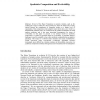Free Online Productivity Tools
i2Speak
i2Symbol
i2OCR
iTex2Img
iWeb2Print
iWeb2Shot
i2Type
iPdf2Split
iPdf2Merge
i2Bopomofo
i2Arabic
i2Style
i2Image
i2PDF
iLatex2Rtf
Sci2ools
ECAL
2001
Springer
2001
Springer
Symbiotic Composition and Evolvability
Several of the Major Transitions in natural evolution, such as the symbiogenic origin of eukaryotes from prokaryotes, share the feature that existing entities became the components of composite entities at a higher level of organisation. This composition of pre-adapted extant entities into a new whole is a fundamentally different source of variation from the gradual accumulation of small random variations, and it has some interesting consequences for issues of lity. In this paper we present a very abstract model of ‘symbiotic composition’ to explore its possible impact on evolvability. A particular adaptive landscape is used to exemplify a class where symbiotic composition has an adaptive advantage with respect to evolution under mutation and sexual recombination. Whilst innovation using conventional evolutionary algorithms becomes increasingly more difficult as evolution continues in this problem, innovation via symbiotic composition continues through successive hierarchical level...
Artificial Intelligence | ECAL 2001 | Pre-adapted Extant Entities | Small Random Variations | Symbiotic Composition |
| Added | 28 Jul 2010 |
| Updated | 28 Jul 2010 |
| Type | Conference |
| Year | 2001 |
| Where | ECAL |
| Authors | Richard A. Watson, Jordan B. Pollack |
Comments (0)

